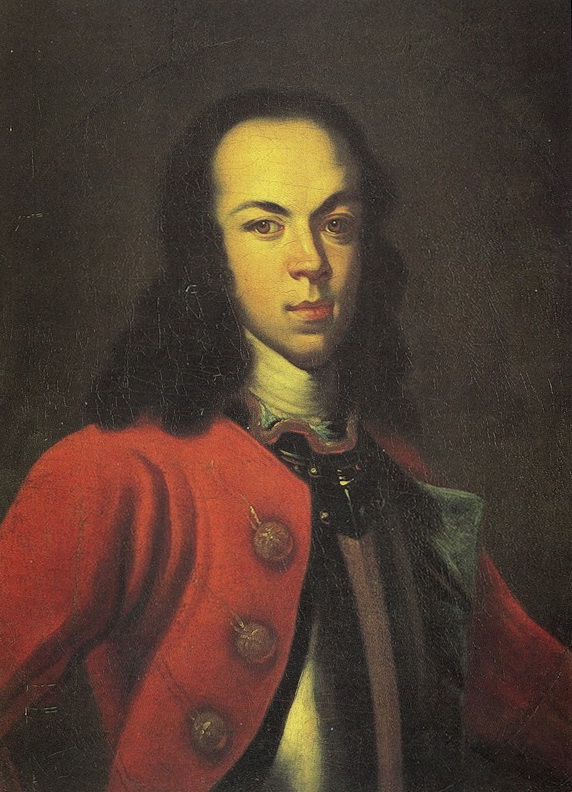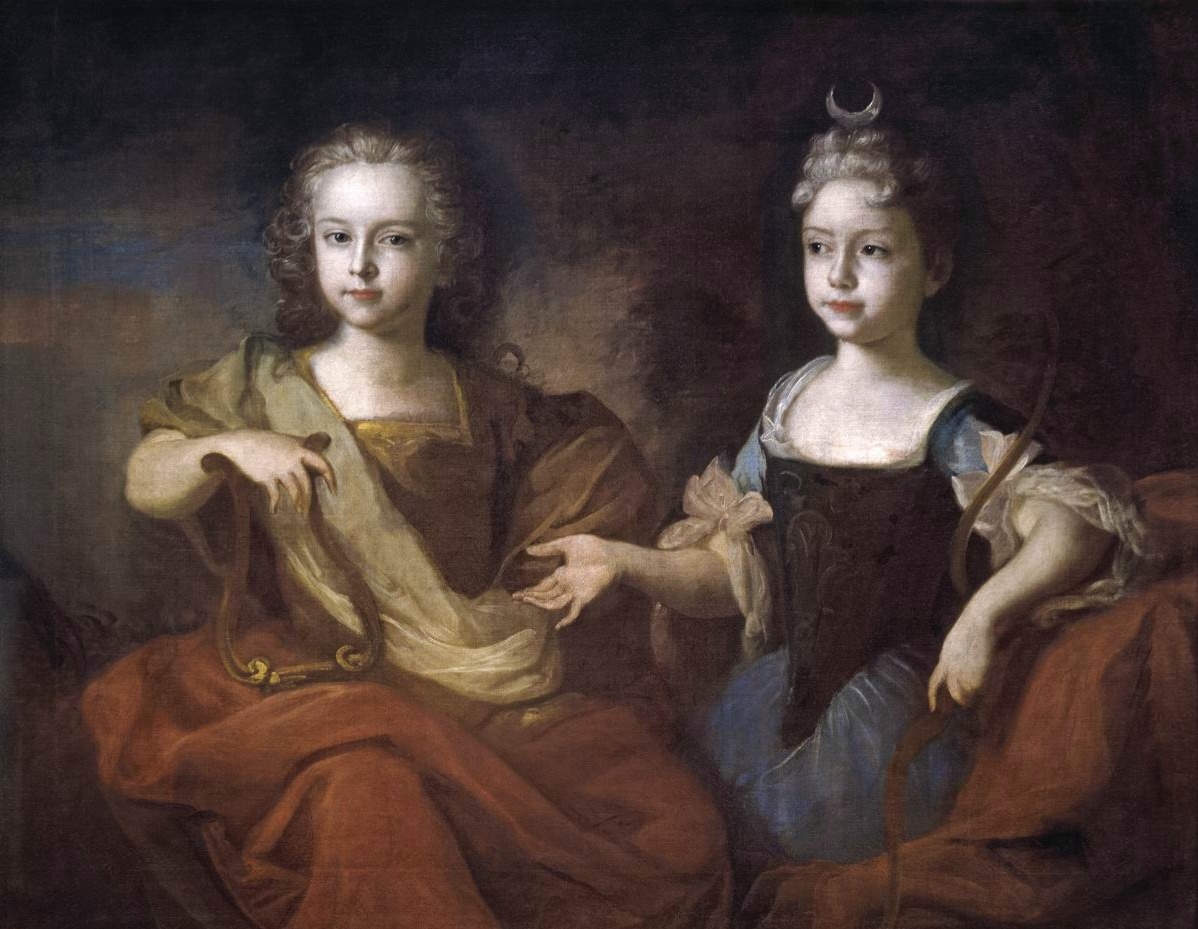by Susan Flantzer © Unofficial Royalty 2018

Alexei Petrovich, Tsarevich of Russia; Credit – Wikipedia
Alexei Petrovich, Tsarevich of Russia, heir to the Russian throne, was the elder of the two sons of Peter I (the Great), Emperor of All Russia and his first wife Eudoxia Feodorovna Lopukhina. He was born on February 28, 1690, at Preobrazhensky, a village east of Moscow where the Romanov tsars had a summer residence. Peter was very proud of his son’s birth and celebrated it with banquets and fireworks.
Alexei had one younger brother who lived to be only seven months old:
- Alexander Petrovich (1691 – 1692)
Alexei had twelve half-siblings from his father’s second marriage to Marta Samuilovna Skavronskaya, renamed Catherine (Ekaterina) Alexeievna, and Peter I’s successor on the Russian throne as Catherine I, Empress of All Russia. All of Alexei’s half-siblings died in childhood except Anna and Elizabeth:
- Pyotr Petrovich born 1704, died in infancy
- Pavel Petrovich born 1705, died in infancy
- Catherine Petrovna (1706 – 1708)
- Grand Duchess Anna Petrovna (1708 – 1728), married Karl Friedrich, Duke of Holstein-Gottorp, had one son Carl Peter Ulrich, the future Peter III, Emperor of All Russia, Anna died of childbirth complications
- Elizabeth, Emperor of All Russia (1709 – 1762), unmarried
- Maria Petrovna of Russia (1713–1715)
- Margarita Petrovna (1714 – 1715)
- Pyotr Petrovich (1715 – 1719)
- Pavel Petrovich (born and died 1717)
- Grand Duchess Natalia Petrovna (1718 – 1725), died from measles a month after her father’s death
- Pyotr Petrovich (born and died 1723)
- Pavel Petrovich (born and died 1724)

Alexei’s mother Eudoxia Feodorovna Lopukhina; Credit – Wikipedia
The marriage of Alexei’s parents was a disaster from the start. Eudoxia was brought up staunchly Russian Orthodox, basically uneducated, and with a strong dislike of anything foreign. Peter I was the complete opposite. Peter had an insatiable curiosity. He was not religious and chose what he wanted to learn about – Russian history, battles, heroes, foreign cities, blacksmithing, carpentry, printing, sailing, and shipbuilding – anything that interested him. By the time Alexei’s younger brother died, Peter was so estranged from Eudoxia that he did not attend his son’s funeral. Peter abandoned his wife for a mistress, Anna Mons, the daughter of a Dutch wine merchant. Their relationship lasted twelve years until Peter met Marta Samuilovna Skavronskaya, first his mistress, then his second wife, and finally his successor on the Russian throne as Catherine I, Empress of All Russia.

Alexie’s father, Peter the Great; Credit – Wikipedia
As Alexei grew up, Peter spent less and less time with him as he was absorbed by his many activities and his mistress Anna Mons. Because of his negative relationship with Eudoxia, Peter avoided her and therefore, also avoided Alexei. Even as a young boy, Alexei sensed the breach between his parents and understood that his father associated him with his mother. Alexei began to see Peter as disapproving and even as a threat. He took his mother’s side and adopted her ways. When Alexei was six years old, Nikifor Kondratievich Vyazemsky became his tutor. Because Eudoxia did not believe in Peter’s Western reforms, Alexei’s education consisted of Bible readings and other religious lessons.
In 1697, Peter traveled incognito to Western Europe on an 18-month tour called the “Grand Embassy”. During his journey, Peter instructed his uncle Lev Naryshkin and Eudoxia’s confessor to persuade Eudoxia to enter a convent and become a nun. Eudoxia disagreed, insisting that her seven-year-old son Alexei needed her. When Peter returned to Russia in August 1698, he continued his relationship with Anna Mons. More dramatically, Peter decided to force Eudoxia into a convent. In September 1698, Eudoxia was finally banished to the Intercession Convent of Suzdal and their marriage was over.
Alexei was placed in the care of Peter’s unmarried sister Tsarevna Natalya Alexeievna, a playwright and founder of the first public theater in Russia. His education now was more in line with his father’s Western reforms. Alexei learned French, German, Latin, mathematics, history, and geography. He read foreign newspapers and exercised by fencing, dancing, riding, and playing ball games.
In 1702, Alexei began his military training. Alexei’s teachers had high opinions of his intellect. His father expected Alexei to completely serve the new, reformed Russia and demanded much from him. Peter’s duties kept him busy and away from Alexei. It was inevitable that the relationship between father and son would become strained. Alexei was often left among nobles and priests who did not like Peter’s reforms and encouraged Alexei to hate his father.
In 1703, it was proposed that Alexei marry Princess Charlotte Christine of Brunswick-Lüneburg. Four years younger than Alexei, Charlotte Christine was the second of the three surviving children (all daughters) of Ludwig Rudolf, Duke of Brunswick-Lüneburg and Princess Christine Luise of Oettingen-Oettingen. Her elder sister Elisabeth Christine of Brunswick-Wolfenbüttel married Karl VI of Austria, Holy Roman Emperor, and was the mother of Empress Maria Theresa and the grandmother of Maria Antonia of Austria, better known as Queen Marie Antoinette of France.

Charlotte Christine of Brunswick-Lüneburg; Credit – Wikipedia
Charlotte Christine was brought up in Dresden in the Electorate of Saxony at the court of Augustus II, King of Poland and Elector of Saxony. Augustus’ wife Christiane Eberhardine of Brandenburg-Bayreuth was Charlotte Christine’s godmother. In 1709, Alexei was sent to Dresden to finish his education and met Charlotte Christine for the first time. Peter I thought that Charlotte Christine was a good diplomatic match because of her sister’s marriage to the Holy Roman Emperor, whose support he would need in his upcoming war with the Turks. On October 25, 1711, 21-year-old Alexei married 17-year-old Charlotte Christine in Torgau, Saxony. The bride was allowed to remain Lutheran but any children would be brought up in the Russian Orthodox religion.
Alexei and Charlotte Christine had two children:
- Grand Duchess Natalia Alexeievna (1714 – 1728), died of tuberculosis at age 14
- Peter II, Emperor of All Russia (1715 – 1730), died of smallpox at age 14

Peter, age 8, and Natalia, age 9; Credit – Автор: Луи Каравак – [1], Общественное достояние, https://commons.wikimedia.org/w/index.php?curid=3844017
In 1715, Peter became dissatisfied with Alexei’s lack of enthusiasm and the lackluster performance of his duties as heir to the throne. Peter sent Alexei a stern letter, urging him to take interest in the affairs of the state and threatening to cut him out of the succession. Alexei, in reply, offered to renounce the succession in favor of his infant son. Peter would agree but only on the condition that Alexei remove himself as a dynastic threat and become a monk.
While Alexei was deciding what to do, he received a letter from his father in August 1716 ordering him to report to Peter and the army without delay if he wished to remain the heir to the throne. Instead, Alexei fled to Vienna and placed himself under the protection of his brother-in-law Karl VI, Holy Roman Emperor, who was married to the sister of Alexei’s deceased wife Charlotte Christine. Peter felt insulted. The flight of the Tsarevich of Russia to a foreign monarch was a scandal. Peter ordered Alexei brought back to Russia at all costs.

Peter the Great interrogating his son Alexei about his plotting; Credit – Wikipedia
Alexei was returned to Russia in January 1718 and Peter began an inquisition regarding Alexei’s behavior. Under torture, Alexei confessed to being involved in a plot to overthrow his father and implicated most of his friends. Alexei’s mother Eudoxia was dragged from her monastery and publicly tried for alleged adultery and transferred to the Ladoga Uspensky Monastery where she lived for seven years under strict supervision until Peter I’s death. Anyone who had befriended Alexei was brutally executed, including Eudoxia’s brother Abram Fedorovich Lopukhin.
Alexei was tried, convicted, and sentenced to be executed. The sentence could be carried out only with Peter’s signed authorization but Peter hesitated making the decision. On July 7, 1718, 28-year-old Alexei died at the Fortress of St. Peter and Paul in St. Petersburg. His death most likely resulted from injuries suffered during his torture. Alexei was buried next to Charlotte Christine at the Peter and Paul Cathedral in St. Petersburg.

Graves of Tsarevich Alexei Petrovich, his wife Charlotte Christine, and aunt Tsarevna Maria Alexeievna; Credit – Wikipedia
This article is the intellectual property of Unofficial Royalty and is NOT TO BE COPIED, EDITED, OR POSTED IN ANY FORM ON ANOTHER WEBSITE under any circumstances. It is permissible to use a link that directs to Unofficial Royalty.
Works Cited
- En.wikipedia.org. (2017). Alexei Petrovich, Tsarevich of Russia. [online] Available at: https://en.wikipedia.org/wiki/Alexei_Petrovich,_Tsarevich_of_Russia [Accessed 21 Dec. 2017].
- En.wikipedia.org. (2017). Charlotte Christine of Brunswick-Lüneburg. [online] Available at: https://en.wikipedia.org/wiki/Charlotte_Christine_of_Brunswick-L%C3%BCneburg [Accessed 21 Dec. 2017].
- Lincoln, W. Bruce. (1981). The Romanovs: Autocrats of All the Russias. New York, NY.: Doubleday
- Massie, Robert K. (1980). Peter The Great: His Life and World. New York, NY.: Alfred A. Knopf
- Ru.wikipedia.org. (2017). Алексей Петрович. [online] Available at: https://ru.wikipedia.org/wiki/%D0%90%D0%BB%D0%B5%D0%BA%D1%81%D0%B5%D0%B9_%D0%9F%D0%B5%D1%82%D1%80%D0%BE%D0%B2%D0%B8%D1%87 [Accessed 21 Dec. 2017].
- Ru.wikipedia.org. (2017). Шарлотта Кристина Брауншвейг-Вольфенбюттельская. [online] Available at: https://ru.wikipedia.org/wiki/%D0%A8%D0%B0%D1%80%D0%BB%D0%BE%D1%82%D1%82%D0%B0_%D0%9A%D1%80%D0%B8%D1%81%D1%82%D0%B8%D0%BD%D0%B0_%D0%91%D1%80%D0%B0%D1%83%D0%BD%D1%88%D0%B2%D0%B5%D0%B9%D0%B3-%D0%92%D0%BE%D0%BB%D1%8C%D1%84%D0%B5%D0%BD%D0%B1%D1%8E%D1%82%D1%82%D0%B5%D0%BB%D1%8C%D1%81%D0%BA%D0%B0%D1%8F [Accessed 21 Dec. 2017].
